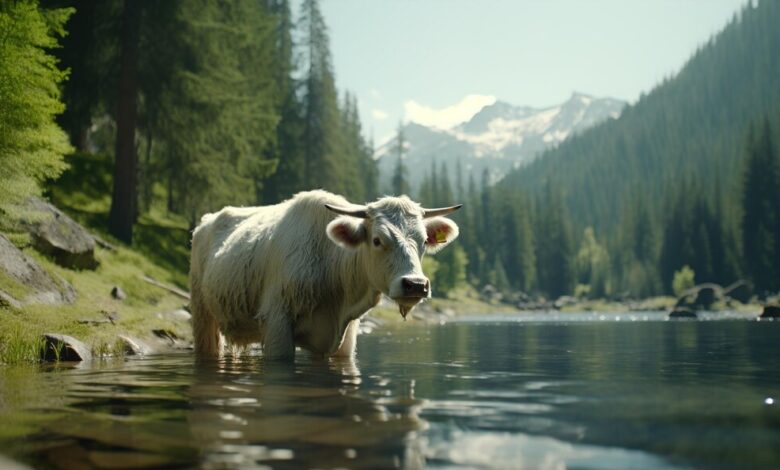The Elusive White Buffalo Calf of Yellowstone Park

Imagine wandering through the majestic landscapes of Yellowstone Park and coming face-to-face with one of the rarest and most mystical creatures on earth—a white buffalo calf. This enchanting sighting would be the highlight of any wildlife enthusiast’s lifetime! In this guide, we’ll uncover the secrets and stories behind these extraordinary animals, giving you the best chance to spot one for yourself.
The Mystical Significance of the White Buffalo Calf
The white buffalo calf holds a special place in Native American culture. Considered sacred, these rare creatures are symbols of hope, peace, and prosperity. Various tribes have legends about the white buffalo, often depicting them as messengers from the Great Spirit. The rarity of a white buffalo calf—occurring once in every 5 million births—adds to its mystical allure.
Historical sightings of white buffalo calves in Yellowstone Park further fuel their legendary status. The park has been home to several such sightings over the years, making it a focal point for those eager to witness this natural wonder. These sightings not only boost the park’s cultural significance but also highlight the importance of preserving our natural heritage.
Physical Characteristics of the White Buffalo Calf
Identifying a white buffalo calf is easier than you might think, but it requires a keen eye. Unlike its brown counterparts, the white buffalo calf has a pristine white coat that stands out against the green and brown hues of Yellowstone’s landscape. Their eyes can range from blue to brown, and some even possess pinkish skin, a trait often linked to albinism. However, not all white buffalo calves are true albinos.
The coat color can change slightly as they age, sometimes turning a light brown or tan. This makes it essential to know the age of the buffalo you are observing. Young calves usually have a softer, almost wool-like fur, which becomes coarser as they grow older. Knowing these distinctions can help you confidently identify a white buffalo calf in the wild.
Understanding Buffalo Behavior and Habitat
Buffalo calves, including the elusive white ones, exhibit specific behaviors that can guide your search. Typically found in herds, these calves stick close to their mothers for protection and nourishment. They are most active during dawn and dusk, making these times ideal for observation.
Yellowstone Park offers diverse habitats that buffalo calves find appealing. Open grasslands, meadows, and river valleys are prime locations where these animals graze and roam. The park’s Lamar Valley, often referred to as the “Serengeti of North America,” is a hotspot for buffalo sightings. Understanding these habitats can significantly increase your chances of spotting a white buffalo calf.
Tips for Spotting a White Buffalo Calf in Yellowstone Park
Spotting a white buffalo calf in Yellowstone Park is no easy feat, but these tips can help enhance your chances. First, timing is crucial. The best times to visit are late spring to early summer when calves are typically born. Early morning and late afternoon are the optimal times for wildlife spotting, as animals are most active.

Next, focus on specific areas known for buffalo activity. Lamar Valley and Hayden Valley are prime locations where herds are frequently seen. Equip yourself with binoculars and a camera with a good zoom lens to capture distant sightings. Patience and persistence are your best allies; sometimes, it takes hours of watching and waiting to catch a glimpse of these rare creatures.
Finally, consider joining guided tours. Expert guides can offer invaluable insights and increase your chances of a successful sighting. They know the best spots, times, and techniques for observing wildlife, providing you with an unforgettable experience.
First-Hand Accounts of White Buffalo Calf Sightings
Hearing from those who’ve been lucky enough to spot a white buffalo calf can be both inspiring and educational. Travel blogger Jane Doe recalls her magical encounter in Lamar Valley. “It was early morning, and the mist was just lifting. Suddenly, there it was—a white buffalo calf, standing majestically with its herd. It felt like a dream.”
John Smith, a seasoned wildlife photographer, shares his tips for success. “Persistence is key. I spent days in Yellowstone before spotting a white buffalo calf. When I finally saw one, it was worth every moment of waiting.”
These stories not only provide hope but also offer practical advice for your own adventure.
The Importance of Conservation Efforts
The rarity of the white buffalo calf underscores the need for robust conservation efforts. These animals face threats from habitat loss, climate change, and human activities. Protecting their natural habitats is crucial for their survival and the preservation of their cultural significance.
Yellowstone Park has long been a leader in wildlife conservation, but continued efforts are essential. Supporting these initiatives through donations, volunteer work, and responsible tourism can make a significant impact. By doing so, you contribute to the well-being of these magnificent creatures and ensure future generations can experience their beauty.
Concluding Thoughts on the White Buffalo Calf
Spotting a white buffalo calf in Yellowstone Park is a rare and magical experience that connects us to nature and our cultural heritage. By understanding their significance, physical characteristics, behavior, and habitat, you can increase your chances of witnessing this natural wonder.
We encourage you to share your own experiences and photos of wildlife sightings. Join the conversation about the beauty and significance of the white buffalo calf. Together, we can raise awareness and support conservation efforts to protect these mystical creatures for generations to come.



